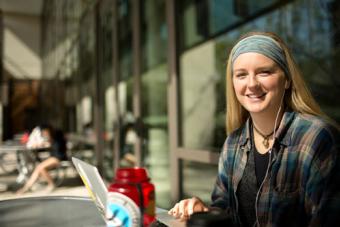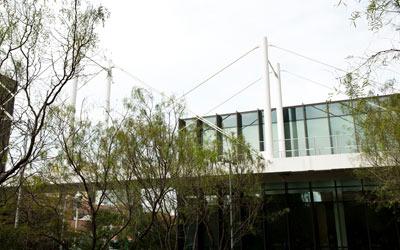The PhD work program must include the following course requirements:
-
Program Specialization: A minimum of 12 semester hours of organized courses and seminars that provide in-depth knowledge of the student’s chosen area of specialization. The doctoral student must complete at least one doctoral-level seminar course organized within SLHS as a part of the program specialization. If the doctoral student does not have a background in Speech, Language and Hearing Sciences, they must complete at least one SLHS graduate-level course (from the MSSLHS/AuD program). Independent study courses contributing to research experiences (e.g. Qualifying research project) can count towards the program specialization requirement.
-
Research Tools: A minimum of 12 semester hours in research design and data analysis. The doctoral student must complete at least two courses involving statistics/statistical methods/research design (to be completed outside SLHS). Doctoral-level seminar coursework focusing on grant-writing can count under the research tool requirement. Independent study contributing to research experiences can count towards the research tool if the study involves experimental design, statistical analyses or data science.
-
Related Area: A related area is defined as the development of a content area as opposed to the development of research techniques. A minimum of 9 semester hours of graduate credit in a field of study outside program specialization. The doctoral student must complete at least one organized course outside SLHS as a part of the related area requirement.
-
Required Teaching Course: Students are required to successfully complete SLH 398T or its equivalent in any other department at UT-Austin, or receive a waiver on the basis of a similar course or prior college teaching experience at another institution. It is highly recommended that students complete this requirement within first two years post MSSLHS/AuD in order to qualify for assistant instructor positions in SLHS.
-
Attendance in Scholarly Talks: Attendance in SLHS seminars, colloquia, outside department seminars (see Attendance at scientific lectures documentation form). All doctoral students are encouraged to regularly attend seminars and talks organized within and outside SLHS as a part of doctoral training. Attendance is required in at least two interdisciplinary seminars (organized outside SLHS) and two SLHS colloquia/seminars per year. A form documenting attendance (signed by the major advisor) must be submitted along with the annual student activity report (on Aug 31st of each year).
The doctoral program in SLHS is a research degree and research experiences are a critical element in the student's doctoral program. Doctoral students are expected to be actively involved in research each semester they are enrolled in the university. In accordance with UT policy, the student may need to receive IRB approval before initiating any research project that involves human or animal subjects.
Qualifying research project (QRP)
The qualifying research project (QRP) should begin in year 1 with the major advisor. It is recommended that the QRP will involve elements of literature review, development of a research design, data collection, analysis, and interpretation. The QRP does not require primary data collection. The doctoral student can sign up for independent study with the advisor during the period of the QRP to ensure continued progress.
QRP Timeline:
-
In year 1, the doctoral student initiates a QRP plan with the advisor. The advisory committee evaluates a draft proposal of the QRP during the work program meeting.
-
In year 1, the QRP proposal is presented to the department during an end-of-the-year student talk series.
-
In year 2, a final written product (reported in journal article format) should be submitted to the advisory committee at least one week before the year 2 advisory committee meeting.
-
The QRP will terminate with an oral defense to the advisory committee by the end of year 2.
Research rotation (RR)
The research rotation (RR) should begin in year 2 with a second mentor (not the primary advisor). The second mentor could be outside CSD. The doctoral student can register for independent study with the second mentor throughout the period of the RR to ensure continued progress.
RR Timeline:
-
In year 2, the doctoral student initiates research rotation with the second mentor. Advisory committee evaluates proposal (year 2).
-
In year 2, the RR is presented to the department for feedback during an end-of-the-year student talk series.
-
A final written product from the RR (reported in journal article format in APA style) should be submitted to the advisory committee at least one week before the candidacy meeting.
Research proposal (RP)
The research proposal is written in National Research Service Award (NRSA) predoctoral training fellowships (F31) format (examples provided here). The RP can be completed anytime between years 1-3 under the discretion of the major advisor. It is highly recommended that the student enrolls in a doctoral-level grant-writing seminar prior to beginning the RP. Pilot data from QRP or RR can be used in the research proposal. It is recommended that the F31 be submitted for external review. For international students, the RP can be reformatted for submission to other grant opportunities (e.g. NSF Dissertation improvement grant. The final written product must be included as a part of the portfolio during the candidacy meeting.
RP Timeline
-
Can be initiated anytime between years 1-3.
-
A final written product from the RP should be submitted to the advisory committee at least one week before the candidacy meeting.
The teaching experiences will enable students to:
(1) plan and present lectures,
(2) participate in the evaluation of student performance.
One or more teaching experiences is required of all students regardless of whether they receive funding as a teaching assistant. To assist students with the development of their teaching skills, they are required to take the course offered by the Center for Teaching Effectiveness (398T). Students are expected to present a teaching portfolio to the Advisory Committee for review and approval during candidacy meeting. The material shall include a detailed syllabus, reading list, assignments, and handouts/overheads/slides if applicable.
At the discretion of the committee, the course may be an adaptation of an existing course, or it may be a course in a topic area in which the student has not previously taught. Implementation of this requirement is left to the student and his/her advisory committee, but the teaching must be mentored by a faculty member. However, the following guidelines are recommended to develop teaching excellence:
(1) prepare and present five (preferably consecutive) lectures
(2) include a plan for the evaluation and grading of material presented in the lectures.
To summarize the requirements described above, students must complete the requirements for (1) Coursework (2) Research experiences and (3) Teaching experiences to be considered for candidacy. The advisory committee will review the candidacy portfolio. The year 3 advisory committee meeting may be combined with the candidacy meeting if the student has met all candidacy requirements by the end of year 3.
The following components of the candidacy portfolio will be evaluated by the committee to assess admission to candidacy:
1. Satisfactory completion of coursework (program specialization, research tools, related area, required teaching, attendance in scholarly talks)
2. Satisfactory completion and defense of QRP, RR, and RP. Written products from the two research projects (QRP, RR) and the RP should be submitted to the committee for review. Additionally, it is expected that the student submits either the QRP or the RR to a peer-reviewed publication outlet as the first author. Evidence demonstrating manuscript submission is expected to be included in the portfolio.
3. Teaching portfolio: teaching statement, syllabus, reading list, assignments, and handouts/overheads/slides for the five lectures.
4. Annual student activity reports from all previous years
5. A brief (60 lines) description of dissertation or proposal
The portfolio is to be presented to the Advisory Committee at least one week prior to the scheduled meeting, defended orally, with special attention to the way the body of work relates to the existing work in the relevant field(s) of study. Approval of the portfolio will be the last step leading to candidacy. The outcome of the defense will be decided by majority vote of the committee.
Prospectus & Dissertation
General
The dissertation is a major research investigation of an original idea. The student first works closely with his/her major professor in order to prepare a concise and understandable prospectus. The major professor, who also serves as the student's adviser, consults with the student in the selection of a dissertation committee and recommends these members to the Graduate Adviser of the SLHS Department for approval by the Graduate School. The dissertation committee consists of at least four faculty members. At least three of the committee members must be from the SLHS Department; at least one must be a faculty member from outside the Department. Although not required, it is anticipated that the faculty member(s) from outside the SLHS Department will be from the student's related area of study.Prospectus meeting
After the prospectus has been circulated to the student's dissertation committee (at least one week prior to the prospectus meeting), a formal meeting is held and the committee approves or rejects the proposed dissertation project following an oral defense.Dissertation
The dissertation includes a detailed literature review and critique, design of an experiment, data collection, presentation and analysis of the results, and a discussion of the implications or significance of the findings. The format of the references should be in keeping with that used in the scholarly journal most appropriate for the subject matter of the study. The completed manuscript is submitted to members of the dissertation committee at least four weeks before the date of the scheduled oral defense. The outcome of the defense will be decided by majority vote of the committee.Dissertation Defense Attendance Options
The student and the supervisor, in negotiation with the dissertation committee members, will have one of two options or a combination of both for the defense: the traditional option of meeting in a room or the virtual (electronic) option of meeting using technology; i.e., teleconferencing or videoconferencing. The intent is that all committee members will participate in the defense either in person or electronically; however, if one committee member that is not the supervisor/co-supervisor is unable to attend the defense, then the member’s absence must be explained, together with an assurance that the dissertation will be read, and if approved, signed.Questions?



